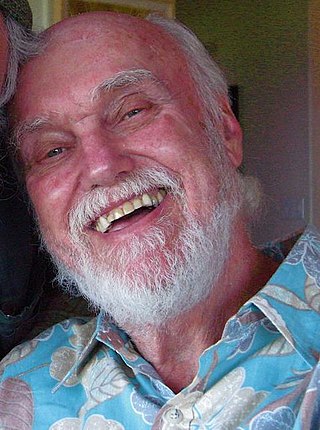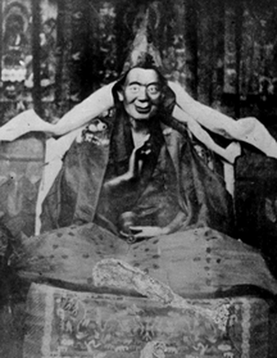
Tibetan Buddhism is a form of Buddhism practiced in Tibet, Bhutan and Mongolia. It also has a sizable number of adherents in the areas surrounding the Himalayas, including the Indian regions of Ladakh, Sikkim, and Arunachal Pradesh, as well as in Nepal. Smaller groups of practitioners can be found in Central Asia, Xinjiang, Inner Mongolia, and some regions of Russia, such as Tuva, Buryatia, and Kalmykia.

Ram Dass, also known as Baba Ram Dass, was an American spiritual teacher, guru of modern yoga, psychologist, and writer. His best-selling 1971 book Be Here Now, which has been described by multiple reviewers as "seminal", helped popularize Eastern spirituality and yoga in the West. He authored or co-authored twelve more books on spirituality over the next four decades, including Grist for the Mill (1977), How Can I Help? (1985), and Polishing the Mirror (2013).

Robert Alexander Farrar Thurman is an American Buddhist author and academic who has written, edited, and translated several books on Tibetan Buddhism. He was the Je Tsongkhapa Professor of Indo-Tibetan Buddhist Studies at Columbia University, before retiring in June 2019. He was the first endowed chair in Buddhist Studies in the West. He also is the co-founder and president of the Tibet House US New York. He translated the Vimalakirti Sutra from the Tibetan Kanjur into English. He is the father of actress Uma Thurman.

The Bardo Thodol, commonly known in the West as The Tibetan Book of the Dead, is a terma text from a larger corpus of teachings, the Profound Dharma of Self-Liberation through the Intention of the Peaceful and Wrathful Ones, revealed by Karma Lingpa (1326–1386). It is the best-known work of Nyingma literature. In 1927 the text was one of the first examples of both Tibetan and Vajrayana literature to be translated into a European language and arguably continues to this day to be the best known.

Kumaon is a revenue and administrative division in the Indian State of Uttarakhand. It spans over the eastern half of the state and is bounded on the north by Tibet, on the east by Nepal, on the south by the state of Uttar Pradesh, and on the west by Garhwal. Kumaon comprises six districts of the state: Almora, Bageshwar, Champawat, Nainital, Pithoragarh and Udham Singh Nagar.

Anagarika Govinda was the founder of the order of the Arya Maitreya Mandala and an expositor of Tibetan Buddhism, Abhidharma, and Buddhist meditation as well as other aspects of Buddhism. He was also a painter and poet.
Buddhism is a legally recognized religion in Austria. Although still small in absolute numbers, Buddhism in Austria enjoys widespread acceptance. A majority of Buddhists in the country are Austrian nationals, while a considerable number of them are foreign nationals.

Sera Monastery is one of the "great three" Gelug university monasteries of Tibet, located 1.25 miles (2.01 km) north of Lhasa and about 5 km (3.1 mi) north of the Jokhang.
Ego death is a "complete loss of subjective self-identity". The term is used in various intertwined contexts, with related meanings. Jungian psychology uses the synonymous term psychic death, referring to a fundamental transformation of the psyche. In death and rebirth mythology, ego death is a phase of self-surrender and transition, as described by Joseph Campbell in his research on the mythology of the Hero's Journey. It is a recurrent theme in world mythology and is also used as a metaphor in some strands of contemporary western thinking.

Almora is a municipal board and a cantonment town in the state of Uttarakhand, India. It is the administrative headquarters of Almora district. Almora is located on a ridge at the southern edge of the Kumaon Hills of the Himalaya range. The Koshi (Kaushiki) and Suyal (Salmale) rivers flow along the city and snow-capped Himalayas can be seen in the background.

Rewalsar or Tso Pema in Tibetan is a small town and a pilgrimage place in a nagar panchayat in Mandi district in India. It is located in the state of Himachal Pradesh. The local name for Rewalsar is Tri Sangam. Rewalsar Lake is a tourist spot in the area.

Walter Yeeling Evans-Wentz was an American anthropologist and writer who was a pioneer in the study of Tibetan Buddhism, and in transmission of Tibetan Buddhism to the Western world, most known for publishing an early English translation of The Tibetan Book of the Dead in 1927. He had three other texts translated from the Tibetan: Tibet's Great Yogi Milarepa (1928), Tibetan Yoga and Secret Doctrines (1935), and The Tibetan Book of the Great Liberation (1954), and wrote the preface to Paramahansa Yogananda's famous spiritual book, Autobiography of a Yogi (1946).
Alfred Julius Emmanuel Sorensen, also known as Sunyata, Shunya, or Sunyabhai, was a Danish mystic, horticulturist and writer who lived in Europe, India and the US.

Freda Bedi, also known as Sister Palmo or Gelongma Karma Kechog Palmo, was an English-Indian social worker, writer, Indian nationalist and Buddhist nun. She was jailed in British India as a supporter of Indian nationalism and was the first Western woman to take full ordination in Tibetan Buddhism.
Neville G. Pemchekov Warwick (1932–1993) was a modern interpreter of Buddhism and a central figure of the spiritual movement of California during the late 1960s and the 1970s. He made an ancient Japanese Buddhist practice of firewalking popular in the USA.

Kasar Devi is a village near Almora, Uttarakhand. It is known for the Kasar Devi temple, a Devi temple, dedicated to Kasar Devi, after whom the place is also named. The temple structure dates to the 2nd century CE. Swami Vivekananda visited Kasar Devi in 1890s, and numerous western seeker, Sunyata Baba Alfred Sorensen and Lama Anagarika Govinda.

Domo Geshe Rinpoche is said to have been Shariputra, the Mahadsiddha Gayadhara, Dharmashri, Munijnana, Tönmi Sambhota, King Trisong Detsen, Dromtönpa, Milarepa, Khedrup Rinpoche, and Dragpa Gyaltsen in previous lives.
Buddhism in Hungary has existed since 1951 when Ernő Hetényi founded the Buddhist Mission in Germany, as a member of the Arya Maitreya Mandala Buddhist order. However, the first Buddhist community had been founded in the 1890s in Máramarossziget. József Hollósy took refuge and wrote Buddhista Kátét (1893) — the first Buddhist catechism in Hungarian. According to this, the Dharma has been present in Hungary for more than a century. In 1933 the Hungarian philologist and Orientalist — author of the first Tibetan-English dictionary and grammar book Sándor Kőrösi Csoma — was recognised as a bodhisattva in Japan. In Hungary József Hollósy is regarded as the second bodhisattva.

Li Gotami Govinda was an Indian painter, photographer, writer and composer. She was also skilled in ballet and stagecraft. She gained fame with her conversion to Mahayana Buddhism and travels in Tibet.
















